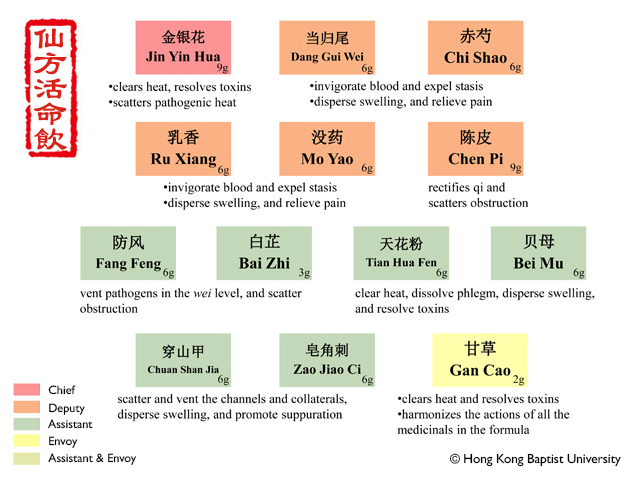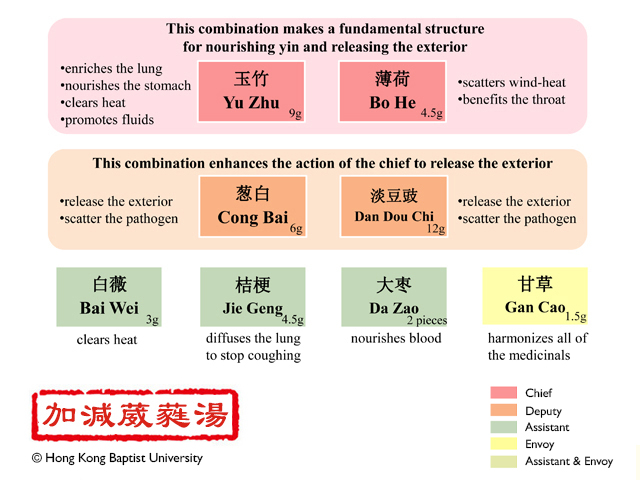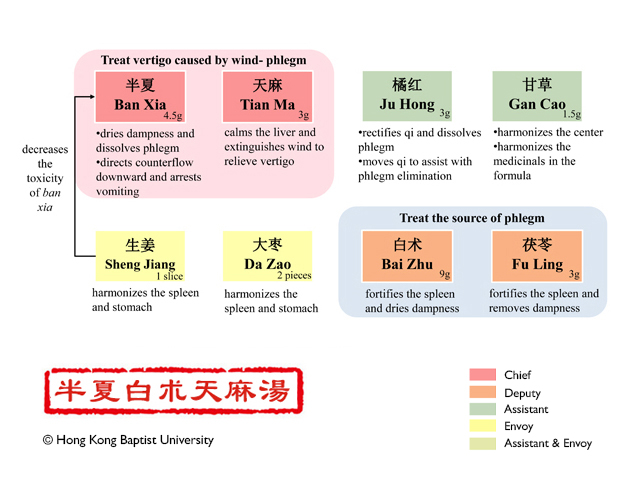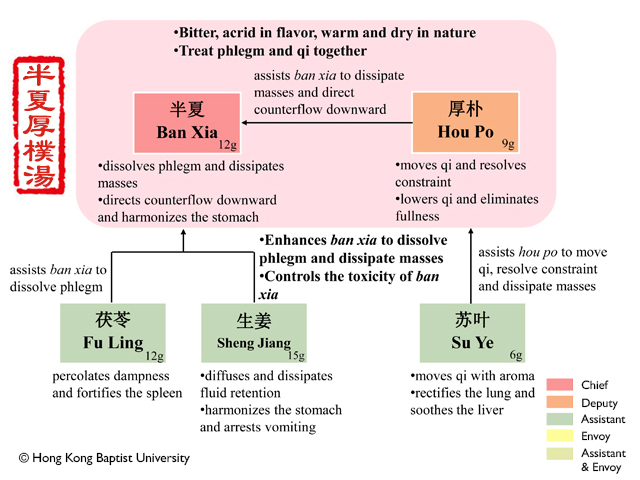| Numbering |
|
Name |
|
Combination |
|
Action |
|
Indication |
|
Thumbnail |
|
37
|
|
Immortal Formula Life-Giving Beverage
|
|
Angelicae Dahuricae Radix; Manis Squama; Glycyrrhizae Radix et Rhizoma; Saposhnikoviae Radix; Myrrha; Paeoniae Radix Rubra; Angelicae Sinensis Radix; Olibanum; Fritillariae Bulbus; Trichosanthis Radix; Gleditsiae Spina; Lonicerae Japonicae Flos; Citri Reticulatae Pericarpium
|
|
Clears heat, resolves toxins, disperses swelling, promotes suppuration, invigorates blood, and relieves pain.
|
|
This formula is indicated for yang patterns in the initial stage with sores, abscesses, and ulcers. The symptoms are redness, swelling, and pain in the affected areas, fear of cold with fever, a thin white or yellow tongue coating, and a forceful, rapid pulse.
|
|

|
|
38
|
|
Solomon's Seal Variant Decoction
|
|
Polygonati Odorati Rhizoma; Allii Fistulosi Bulbus; Platycodonis Radix; Cynanchi Atrati Radix et Rhizoma; Sojae Semen Praeparatum; Menthae Herba; Glycyrrhizae Radix et Rhizoma; Jujubae Fructus
|
|
Nourishes yin and releases the exterior.
|
|
Jia Jian Wei Rui Tang is indicated for the pattern of yin deficient with external contraction of wind-heat. The signs and symptoms are headache, fever, slight aversion to wind-cold, absence of or a little bit of sweat, cough, vexation, thirst, dry throat, a red tongue, and a rapid pulse.
|
|

|
|
39
|
|
Pinellia, Atractylodes Macrocephala and Gastrodia Decoction
|
|
Pinelliae Rhizoma; Gastrodiae Rhizoma; Poria; Citri Expocarpium Rubrum; Atractylodis Macrocephalae Rhizoma; Glycyrrhizae Radix et Rhizoma; Zingiberis Rhizoma Recens; Jujubae Fructus
|
|
Dries dampness and dissolves phlegm, calms the liver and extinguishes wind.
|
|
Ban Xia Bai Zhu Tian Ma Tang is designed to treat the pattern of wind-phlegm harassing the upper body. Symptoms include dizziness, headache, pi and oppression in the chest and diaphragm, nausea, and vomiting. The tongue coating is greasy and white. The pulse is wiry and slippery.
|
|

|
|
40
|
|
Pinellia and Officinal Magnolia Bark Decoction
|
|
Pinelliae Rhizoma; Magnoliae Officinalis Cortex; Poria; Zingiberis Rhizoma Recens; Perillae Folium
|
|
Moves qi and dissipates masses, directs counterflow downward and dissolves phlegm.
|
|
Ban Xia Hou Po Tang is indicated for plum-stone qi (globus hystericus). The symptoms are fullness and tightness in the chest and diaphragm, coughing, and vomiting. The tongue coating is white and moist or white and glossy. The pulse is wiry and slow or wiry and slippery.
|
|

|

